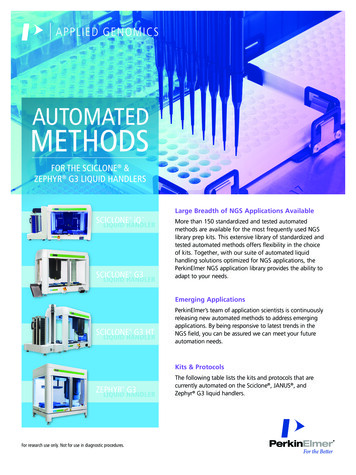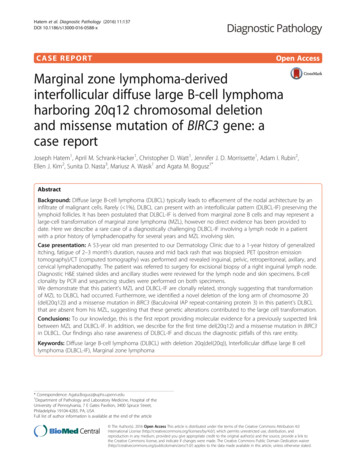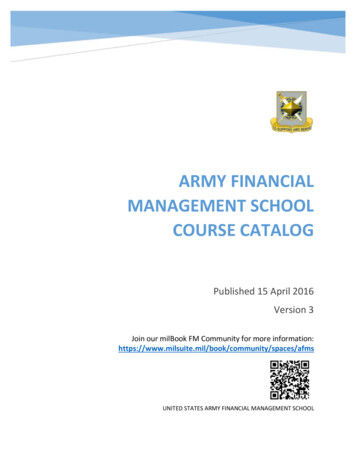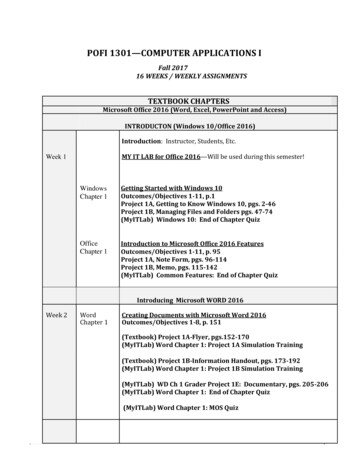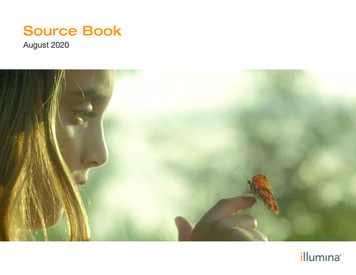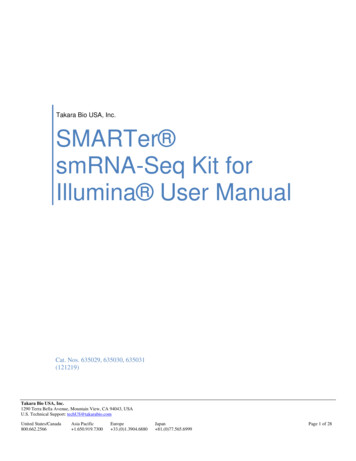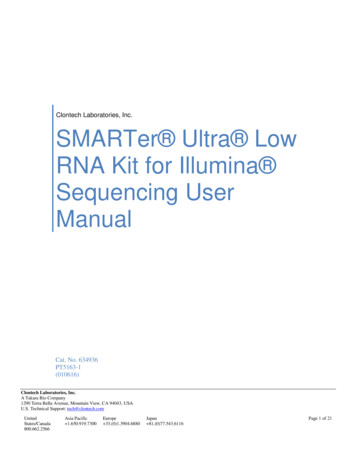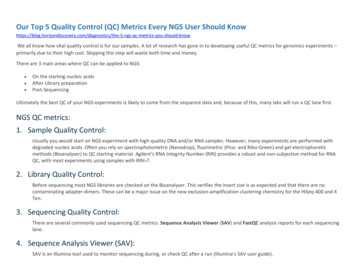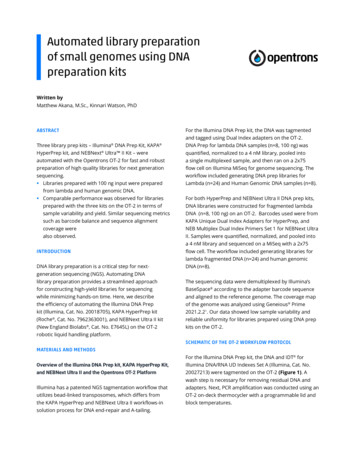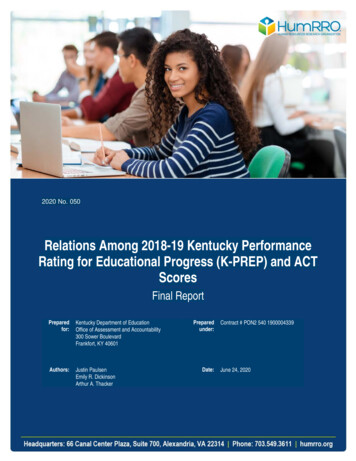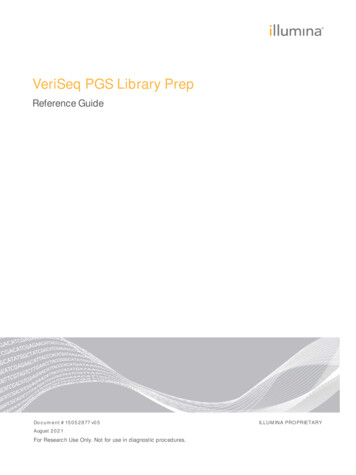
Transcription
VeriSeq PGS Library PrepReference GuideDo c u m e n t # 15 0 5 2 8 77 v0 5August 2 0 2 1For Research Use Only. Not for use in diagnostic procedures.ILLUM IN A PRO PRIETARY
Ve riSe q PG S Lib rary Pre p Re fe re n c e G u id eThis document and its contents are proprietary to Illumina, Inc. and its affiliates ("Illumina"), and are intended solely for thecontractual use of its customer in connection with the use of the product(s) described herein and for no other purpose. Thisdocument and its contents shall not be used or distributed for any other purpose and/or otherwise communicated,disclosed, or reproduced in any way whatsoever without the prior written consent of Illumina. Illumina does not convey anylicense under its patent, trademark, copyright, or common-law rights nor similar rights of any third parties by thisdocument.The instructions in this document must be strictly and explicitly followed by qualified and properly trained personnel in orderto ensure the proper and safe use of the product(s) described herein. All of the contents of this document must be fullyread and understood prior to using such product(s).FAILURE TO COMPLETELY READ AND EXPLICITLY FOLLOW ALL OF THE INSTRUCTIONS CONTAINED HEREIN MAYRESULT IN DAMAGE TO THE PRODUCT(S), INJURY TO PERSONS, INCLUDING TO USERS OR OTHERS, AND DAMAGETO OTHER PROPERTY, AND WILL VOID ANY WARRANTY APPLICABLE TO THE PRODUCT(S).ILLUMINA DOES NOT ASSUME ANY LIABILITY ARISING OUT OF THE IMPROPER USE OF THE PRODUCT(S) DESCRIBEDHEREIN (INCLUDING PARTS THEREOF OR SOFTWARE). 2021 Illumina, Inc. All rights reserved.All trademarks are the property of Illumina, Inc. or their respective owners. For specific trademark information, seewww.illumina.com/company/legal.html.Do c u m e n t # 15 0 5 2 8 77 v0 5For Research Use Only. Not for use in diagnostic procedures.ii
Ve riSe q PG S Lib rary Pre p Re fe re n c e G u id eRevision HistoryDocumentDateDocument # 15052877v05August2021Document # 15052877v04September2020Description of Change Updated normalized library preparation information. Reconfigure introduction.Added multiplexing information.Updated Warnings and Precautions.Updated Qubit 2.0 or greater Fluorometer in Consumables andEquipment.Added dye aliquot best practices to Quantification Methods andQubit Method.Added Quant-iT dsDNA HS steps to Quant-iT Method.Added cluster density information to Pooling Libraries for the MiSeqSystem.Updated instructions for preparing ATM and TD in Tagment InputDNA.Removed 1 rxn values from table in Normalize Libraries Preparation.Removed duplicate step of adding 10 μl of each λ DNA standard toseparate wells during the Quant-iT Method procedure.Material # 20007092Document # 15052877v03April2016 Added links to documents in Additional Resources. Edited Quantify Unpurified SurePlex Products description—Quant-iTHS DNA Assay Kit recommendation. Corrected step in Normalize Libraries section to vortex LNA1/LNB1mix. Removed SCT and SLB from Acronyms list.Material # 20004574Document # 15052877v02January2016 Added volume for SurePlex amplification product in Tagmentation ofSurePlex WGA Product section. Corrected index adapter instructions in PCR Amplification section. Added volume for PCR product in PCR-Clean-Up Procedure section.Material # 20000347Document # 15052877v01September2015Part # 15052877 Rev. AJune2014 Updated to new library prep style.Initial release.Do c u m e n t # 15 0 5 2 8 77 v0 5For Research Use Only. Not for use in diagnostic procedures.iii
Table of ContentsChapter 1 Overview1IntroductionRecommendationsAdditional Resources112Chapter 2 Protocol4IntroductionTips and TechniquesLibrary Prep WorkflowQuantify Unpurified SurePlex ProductsTagment Input DNAAmplify Tagmented DNAClean Up PCRNormalize LibrariesPool Libraries for the MiSeq System4466911121518Appendix A Supporting Information20IntroductionAcronymsPCR Clean-Up Quality ControlVeriSeq PGS Library Prep Kit ContentsConsumables and Equipment2020202022Technical Assistance25Do c u m e n t # 15 0 5 2 8 77 v0 5For Research Use Only. Not for use in diagnostic procedures.iv
Chapter 1 OverviewIntroductionRecommendationsAdditional Resources112IntroductionThe VeriSeq PGS Library Prep uses an engineered transposome to simultaneously fragment and tag("tagment") SurePlex input DNA, adding unique adapter sequences in the process. A limited-cycle PCRreaction uses the adapter sequences to amplify the SurePlex insert DNA. The PCR reaction also addsindex sequences to both ends of the DNA, enabling single-indexed sequencing of up to 12 pooled librariesand dual-indexed sequencing of up to 24 pooled libraries on the MiSeq System.This protocol describes the procedures for preparing sequencing libraries of PGS samples.This protocol explains how to:uPrepare up to 12 single-index OR up to 24 dual-index, single-read libraries from SurePlex amplificationproductsuPrepare multiplexed library pools for cluster generation and sequencing on the MiSeq System.The VeriSeq TM PGS Library Preparation protocol offers:uFast and easy library preparationuLow DNA input (only 1 ng unpurified SurePlex double-stranded DNA (dsDNA) required)uMaster mixed reagents to reduce reagent containers, pipetting, and hands-on timeuInnovative sample normalization that eliminates the need for library quantification before samplepooling and sequencingRecommendationsThe VeriSeq PGS solutions are manufactured in batches, called lots, in accordance with strict qualitystandards. Each component or reagent in each lot is tested to work with other reagents in the kit. Toensure proper performance, do not interchange, mix, or combine reagents from different kits and lots.Library Pooling and MultiplexinguUsing alternative indexes or indexes combination can compromise your test results.uDo not exceed the maximum multiplexing capacity of 24 pooled libraries. Exceeding the maximum of24 pooled libraries causes an error in the MiSeq Control Software and prevents a VeriSeq PGS runfrom starting.uHigher level of multiplexing might affect the data quality, resulting in poorer overall kit performance.Warnings and PrecautionsuCheck the documentation and safety data sheets (SDS) for guidelines on handling, preparing, anddisposing kit components, intermediate mixtures, or wastes. For more information, see the SDS forthis kit at support.illumina.com/sds.html.uAvoid cross-contamination during the library preparation steps. Contamination of reagents cancompromise your test results.u Discard used materials without passing them over open containers.Do c u m e n t # 15 0 5 2 8 77 v0 5For Research Use Only. Not for use in diagnostic procedures.1
Ve riSe q PG S Lib rary Pre p Re fe re n c e G u id euuuuTo minimize the risk of contamination, label and use separate reservoirs for each reagent.Make sure that index containers do not contact each other.Change caps between each index use.Change gloves if they come in contact with indexes.uIncubation times, incubation temperature, and pipetting volumes that differ from those specified in thisprotocol can lead to suboptimal library quality and compromise your test results.uShipping conditions might differ from storage conditions. Some kit components must be brought toroom temperature before use.uAll components have an expiration date. Do not use kit components beyond the expiration dateprinted on component labels.uDo not add sodium azide as a preservative to any of the components.uThis kit is intended for use by qualified laboratory staff.DNA Input RecommendationsThe VeriSeq PGS solution begins with DNA amplification from a single embryonic cell or multipleembryonic cells using the SurePlex DNA Amplification Kit. For more information, see the SurePlexSummary Protocol (part # 15053626).The VeriSeq PGS Library Prep Kit protocol is optimized for 1 ng of input SurePlex amplified DNA.Illumina strongly recommends quantifying the starting SurePlex amplified dsDNA. Steps for quantificationare included in this protocol.DNA Input QuantificationVeriSeq PGS Library Prep uses an enzymatic DNA fragmentation step and thus can be more sensitive toDNA input compared to mechanical fragmentation methods. The ultimate success of the assay stronglydepends on using an accurately quantified amount of input DNA library. Therefore, the correctquantification of the DNA library is essential.To obtain an accurate quantification of the DNA library, quantify the starting DNA library using afluorometric based method specific for duplex DNA such as the Quant-iT HS DNA Assay Kit. Avoidmethods that measure total nucleic acid content (eg, NanoDrop or other UV absorbance methods)because common contaminants such as ssDNA, RNA, and oligos are not substrates for the VeriSeq PGSassay. These contaminants can cause an overestimation of viable material, resulting in poorer overallperformance.Additional ResourcesThe following documentation is available for download from the Illumina website.ResourceDescriptionVeriSeq PGS Library PrepProtocol Guide (document #1000000000812)Provides only protocol instructions.The protocol guide is intended for experienced users. For new or less experienced users,see the VeriSeq PGS Library Prep Reference Guide.VeriSeq PGS Library PrepChecklist (document #1000000000813)Provides a checklist of the protocol steps.The checklist is intended for experienced users. For new or less experienced users, seethe VeriSeq PGS Library Prep Reference Guide.Do c u m e n t # 15 0 5 2 8 77 v0 5For Research Use Only. Not for use in diagnostic procedures.2
Ve riSe q PG S Lib rary Pre p Re fe re n c e G u id eResourceDescriptionBlueFuse Workflow ManagerQuick Reference Guide(document # 15056206)Provides information about creating and editing appropriate sample sheets for Illuminasequencing systems and analysis software and recording parameters for your sampleplate.SurePlex Summary Protocol(document # 15053626)Describes the protocol for cell lysis and DNA amplification from an embryo biopsy usingthe SurePlex DNA Amplification Kit.BlueFuse Multi SoftwareReference Guide (document# 15053620)Provides information about the BlueFuse Multi sequencing data analysis tool.MiSeq Reagent Kit v3-PGSReagent Prep Guide(document # 15055896)Describes the method for the preparation of reagents from the VeriSeq PGS Kit-MiSeq.VeriSeq PGS GuidanceTechnical Note (document #1000000138837)Provides guidance on concentration requirements of undiluted SurePlex samples forVeriSeq PGS library preparation, in addition to the quality control metrics supplied inBlueFuse Multi and Sequence Analysis Viewer (SAV).Visit the VeriSeq PGS Library Prep support pages on the Illumina website for requirements andcompatibility, additional documentation, software downloads, online training, frequently asked questions,and best practices.For more information about updates to the MiSeq Control Software, visit the MiSeq support pages on theIllumina website.Do c u m e n t # 15 0 5 2 8 77 v0 5For Research Use Only. Not for use in diagnostic procedures.3
Chapter 2 ProtocolProtocolIntroductionTips and TechniquesLibrary Prep WorkflowQuantify Unpurified SurePlex ProductsTagment Input DNAAmplify Tagmented DNAClean Up PCRNormalize LibrariesPool Libraries for the MiSeq System4466911121518IntroductionThis chapter describes the VeriSeq PGS Library Prep protocol.uFollow the protocols in the order shown, using the specified volumes and incubation parameters.Incubation times, incubation temperatures, and pipetting volumes other than those specified ormissing any centrifuge or mixing steps will lead to suboptimal DNA sequencing libraries andcompromise your test results.uReview Best Practices from the VeriSeq PGS support page on the Illumina website.uReview your kit contents and make sure that you have all required consumables and equipment.Tips and TechniquesUnless a safe stopping point is specified in the protocol, proceed immediately to the next step.Avoiding Cross-ContaminationuWhen adding or transferring samples, change tips between each sample.uWhen adding adapters or primers, change tips between each row and each column.uRemove unused index adapter tubes from the working area.uDo not reuse index adapter tube caps. Use the index adapter replacement caps supplied in the kit.Sealing the PlateuAlways seal the 96-well plate before the following steps in the protocol:u Shaking stepsu Mixing stepsu Centrifuge stepsu Vortexing stepsu Thermal cycling stepsuApply the adhesive seal to cover the plate and seal with a rubber roller.Plate TransfersuWhen transferring volumes between plates, transfer the specified volume from each well of a plate tothe corresponding well of the other plate.Do c u m e n t # 15 0 5 2 8 77 v0 5For Research Use Only. Not for use in diagnostic procedures.4
Ve riSe q PG S Lib rary Pre p Re fe re n c e G u id euIf beads are aspirated into the pipette tips, dispense back to the plate on the magnetic stand and waituntil the liquid is clear ( 2 minutes).Handling BeadsuPipette bead suspension slowly.uWhen mixing, mix thoroughly.uTo remove the supernatant, use a multichannel pipette and 200 µl barrier pipette tips with the plungerdown. Place the tip opposite the aggregated beads and aspirate the supernatant. Dispense anyaspirated beads back into the plate, and then leave the plate on the magnet for 2 minutes or until theliquid is clear.uTo avoid sample loss, confirm that no beads remain in the pipette tips after resuspension and mixingsteps.uWhen washing beads:u Use the appropriate magnet for the plate. For more information, see Consumables and Equipmenton page 22.u Dispense the liquid on the opposite side of the bead pellet so that the beads on the side of thewells are wetted.u Keep the plate on the magnet until the instructions specify to remove it.u Do not agitate the plate while on the magnetic stand. Do not disturb the bead pellet.Do c u m e n t # 15 0 5 2 8 77 v0 5For Research Use Only. Not for use in diagnostic procedures.5
Ve riSe q PG S Lib rary Pre p Re fe re n c e G u id eLibrary Prep WorkflowThe following diagram illustrates the workflow using the VeriSeq PGS Library Prep Kit. This protocol isperformed in the post-PCR lab.Figure 1 Workflow DiagramQuantify Unpurified SurePlex ProductsLibrary preparation uses an enzymatic DNA fragmentation step, which can be more sensitive to dsDNAinput compared to mechanical fragmentation methods. The success of the assay depends on usingaccurately quantified input dsDNA.Avoid methods that measure total nucleic acid content (eg, NanoDrop or UV absorbance methods).Common contaminants such as ssDNA, RNA, and oligonucleotides are not substrates for the VeriSeqPGS assay.Reduced quantification accuracy dramatically lowers the number of clusters generated during sequencing,resulting in less data per sample. This reduction in data significantly impacts aneuploidy calls for affectedsamples.Do c u m e n t # 15 0 5 2 8 77 v0 5For Research Use Only. Not for use in diagnostic procedures.6
Ve riSe q PG S Lib rary Pre p Re fe re n c e G u id eUse 1 of the following kits to quantify the dsDNA content of unpurified SurePlex products.uThe Qubit dsDNA HS Assay Kit (tube format) measures dsDNA concentration in individual tubes andrequires a Qubit 2.0 or later.uThe Quant-iT HS DNA Assay Kit (96-well plate format) measures dsDNA concentration in a microplateand requires a microplate reader. This is the recommended method to use to accurately andreproducibly quantify SurePlex PCR product while reducing hand-on time.NOTEThe Quant-iT HS DNA Assay Kit leads to more consistent libraries.Consumables and Equipmentu96-well PCR plateuMolecular grade wateruFor tube format:u Qubit dsDNA HS Assay Kitu Qubit Assay Tubes (1 tube per sample)u Qubit 2.0 or greater Fluorometeru Adhesive PCR sealuFor plate format:u Quant-iT HS dsDNA Assay Kitu 96-well nonbinding black microplateu Microplate readeru Adhesive PCR sealAbout ReagentsuDiluted Quant-iT dsDNA HS reagent and Qubit dsDNA HS reagent are stable for at least 3 hours atroom temperature, kept away from light.Preparation1Protect the Qubit dsDNA HS reagent from light.2Allow quantification reagents to reach room temperature.ProcedurePrepare 1/10 Dilutions of SurePlex Sample and Controls1Vortex each sample and control.2Centrifuge at 280 g for 1 minute.3In a new PCR plate, add 45 μl molecular-grade water to the required wells.4Add 5 μl sample or control to the wells containing molecular-grade water.5Seal the plate and briefly vortex to mix.6Centrifuge at 280 g for 1 minute.7Set aside on wet ice.Do c u m e n t # 15 0 5 2 8 77 v0 5For Research Use Only. Not for use in diagnostic procedures.7
Ve riSe q PG S Lib rary Pre p Re fe re n c e G u id eQuantification MethodsNOTEReview the manufacturer instruction manuals and safety recommendations before quantifying thesamples.Keep the Qubit or Quant-iT dsDNA HS reagent concentrate and the working solution away from light.Make sure that all quantification reagents are at room temperature before performing the readings.Dye should not undergo multiple freeze and thaw cycles. Best practice is to aliquot it into single-usealiquots.Qubit Method1Prepare the working solution according to the manufacturer instructions.2To calibrate the Qubit fluorometer, add 10 μl of each standard to 190 μl of working solution. For moreinformation, see the Qubit dsDNA HS Assay Kit user guide.3Add 10 μl of the 1/10 diluted SurePlex sample and 190 μl working solution to each assay tube. Brieflyvortex to mix.NOTEIf necessary, adjust to 1–20 μl of sample and 180–199 μl of working solution for a total volume of 200μl.4For optimal fluorescence, incubate the assay tubes for 2 minutes.5Calculate the concentration of each 1/10 diluted SurePlex sample as described by the Qubit dsDNAHS Assay Kit user guide. Convert the units to ng/μl.Quant-iT Method (Recommended Quantification Method)1Dispense the Quant-iT dsDNA HS reagent in single-use aliquots (standard 8-well PCR strip format)to prevent freeze and thaw cycles. Protect the aliquots from light. Store the aliquots at 2-8 C uponuse. Prior to use, bring one aliquot to temperature in the dark.2Prepare the working solution according to the manufacturer instructions by aliquoting the volume ofQuant-iT dsDNA HS buffer required for the experiment and bringing it to room temperature (neveruse Quant-iT buffer cold). Store the Quant-iT buffer bulk cold.3Add 190 μl working solution to the microplate wells that will contain samples or controls.4Add 10 μl of each 1/10 diluted SurePlex sample to separate wells. Create duplicates or triplicates ofthe unknown samples. Pipette to mix.NOTEIf necessary, adjust to 1–20 μl of sample and 180–199 μl of working solution for a total volume is 200μl.5Add 10 μl of each λ DNA standard to separate wells. Do not introduce nuclease into the tubes of DNAstandard as you remove aliquots for the assay. Create duplicates or triplicates of the standards.Pipette to mix.Do c u m e n t # 15 0 5 2 8 77 v0 5For Research Use Only. Not for use in diagnostic procedures.8
Ve riSe q PG S Lib rary Pre p Re fe re n c e G u id e6Measure the fluorescence using a microplate reader.Standard fluorescein wavelengths (excitation/emission at 480/530 nm) are appropriate for this dye.The fluorescence signal is stable for 3 hours at room temperature, protected from light.7Calculate the concentration of each 1/10 diluted SurePlex sample using the plate reader software.Convert the units to ng/μl.Use a standard curve to determine the DNA concentration. For λ DNA standards, plot amount vs.fluorescence and fit a straight line through the data points.NOTEThe fluorescence of the Quant-iT dsDNA HS reagent bound to dsDNA is linear from 0 ng to 100 ng.For best results at the low end of the standard curve, force the line through the background point (orthrough 0, if background has been subtracted).Template Dilution to 0.2 ng/μlNOTEThe SurePlex samples and controls must be diluted according to the BlueFuse Workflow Managercalculations. Make sure to use the 1/10 diluted SurePlex samples and controls from the previous steps.Do not use stock or undiluted stock material.1Using BlueFuse Workflow Manager, enter the calculated dsDNA concentration (ng/μl) of the 1/10diluted SurePlex sample concentration into the 1/10 dsDNA (ng/ul) column of the VeriSeq PGS–MiSeqAssay Plate.The BlueFuse Workflow Manager calculates the molecular-grade water required to prepare 5 μl ofdiluted sample at the final concentration of 0.2 ng/μl.2According to the BlueFuse Workflow Manager calculations, add the appropriate volumes of moleculargrade water to a new PCR plate.3Add 5 μl of the 1/10 diluted SurePlex sample to each well of the plate containing molecular-gradewater.4Vortex, and then centrifuge the plate at 280 g for 1 minute.NOTEDo not pipette to mix. This method leads to poor index representation.5Set aside on wet ice.Tagment Input DNAIn this step, the SurePlex amplification product is tagmented (tagged and fragmented) by the VeriSeq PGStransposome.ConsumablesuATM (Amplicon Tagment Mix)uTD (Tagment DNA Buffer)uNT (Neutralize Tagment Buffer)uSurePlex amplification product (diluted at 0.2 ng/µl)u96-well PCR plateDo c u m e n t # 15 0 5 2 8 77 v0 5For Research Use Only. Not for use in diagnostic procedures.9
Ve riSe q PG S Lib rary Pre p Re fe re n c e G u id euAdhesive PCR sealuPCR 8-tube stripsPreparation1Prepare the following consumables.ReagentStorageInstructionsATM-25 C to -15 CThaw on ice for 20 minutes. Gently invert the thawed tubes 3–5 times, andthen centrifuge briefly. Do not overcentrifuge.TD-25 C to -15 CThaw on ice for 20 minutes. Gently invert the thawed tubes 3–5 times, andthen centrifuge briefly. Do not overcentrifuge.NT2 C to 8 CLet stand for 30 minutes to bring to room temperature.Briefly vortex, and then briefly centrifuge.ProcedureTagmentation of SurePlex WGA Product1Label a new PCR plate VTA (VeriSeq Tagment Amplicon Plate).2Calculate the total volume of TD for all reactions. Using a multichannel pipette, divide the volumeequally among the wells of a PCR 8-tube strip, or use a reservoir.3Add 10 µl TD Buffer to each well.4Add 5 µl ATM to the wells containing TD Buffer.5Add 5 µl SurePlex amplification product (diluted at 0.2 ng/µl) to each sample well.6Mix at 1,800 rpm for 1 minute.7Centrifuge at 280 g for 1 minute.8Make sure that each well contains a volume of 20 µl. Record any nonuniform volumes.9Immediately place on a thermal cycler with a heated lid and run the following program:u 55 C for 5 minutesu Hold at 10 CNOTETo prevent overtagmentation, proceed immediately to the next step.Neutralization of the Tagmented SurePlex DNA1Calculate the total volume of NT buffer required for all reactions. Using a multichannel pipette, dividethe volume equally among the wells of a PCR 8-tube strip.2Add 5 µl NT Buffer to each well.3Mix at 1800 rpm for 1 minute.4Centrifuge at 280 g for 1 minute.5Make sure that each well contains a volume of 25 µl. Record any nonuniform volumes.6Incubate at room temperature for 5 minutes.Do c u m e n t # 15 0 5 2 8 77 v0 5For Research Use Only. Not for use in diagnostic procedures.10
Ve riSe q PG S Lib rary Pre p Re fe re n c e G u id eNOTEProceed immediately to the next step.Amplify Tagmented DNAIn this step, the tagmented DNA is amplified using a limited-cycle PCR program. The PCR step adds Index1 (i7) and Index 2 (i5) adapters. Use the full amount of input DNA to ensure high-quality sequencingresults. Do not add extra PCR cycles.Consumables and EquipmentuNPM (Nextera PCR Master Mix)uIndex 1 primers (N701 to N712)uIndex 2 primers (S503 and S504)uTruSeq Index Plate FixtureuAdhesive PCR sealuPlate sealerPreparation12Prepare the following consumables.ReagentStorageInstructionsNPM-25 C to -15 CThaw on ice for 20 minutes.Invert each tube to mix. Centrifuge briefly using a 1.7 ml Eppendorf tube.Index adapters(i5 and i7)-25 C to -15 CThaw at room temperature for 20 minutes.Invert each tube to mix. Centrifuge briefly using a 1.7 ml Eppendorf tube.Save the following program on a thermal cycler with a heated lid:u 72 C for 3 minutesu 95 C for 30 secondsu 12 cycles of:u 95 C for 10 secondsu 55 C for 30 secondsu 72 C for 30 secondsu 72 C for 5 minutesu Hold at 4 CProcedure1Print the sample assay plate layout using the BlueFuse Workflow Manager.NOTEIf less than a full set of libraries is pooled for sequencing, use the default index layout and use theBlueFuse Workflow Manager to make sure that the correct index adapters are selected.2Arrange the index primers in the TruSeq Index Plate Fixture, as follows:u Index 1 (i7) adapters: N701–N712 in columns 1–12u Index 2 (i5) adapters: S503 in row A, S504 in row CDo c u m e n t # 15 0 5 2 8 77 v0 5For Research Use Only. Not for use in diagnostic procedures.11
Ve riSe q PG S Lib rary Pre p Re fe re n c e G u id eFigure 2 TruSeq Index Plate Fixture (24-Plex Libraries)A Columns 1–12: Index 1 (i7) adapters (orange caps)B Rows A and C: Index 2 (i5) adapters (white caps)3Place the plate on the TruSeq Index Plate Fixture.4Add index adapters according to the sample assay plate layout.u Add 5 μl of each Index 1 (i7) adapter to each column.u Add 5 μl of each Index 2 (i5) adapter to each row.NOTETo avoid cross-contamination, change tips between each well. Discard the original index caps andapply the new caps provided in the kit. After use, remove all index adapter tubes from the workingarea.5Add 15 μl NPM to each well.6Mix at 1800 rpm for 1 minute.7Centrifuge at 280 g for 1 minute.8Make sure that each well contains a volume of 50 µl. Record any nonuniform volumes.9Place on the thermal cycler and run the saved program.SAFE STOPPING POINTIf you are stopping, store at -25 C to -15 C for up to 7 days.Clean Up PCRThis step uses AMPure XP beads to purify amplified DNA from the samples, and provides a size selectionstep that removes both the short library fragments and Primers from the population.Do c u m e n t # 15 0 5 2 8 77 v0 5For Research Use Only. Not for use in diagnostic procedures.12
Ve riSe q PG S Lib rary Pre p Re fe re n c e G u id eNOTEAfter PCR cleanup, samples are double-stranded DNA of a few hundred base pairs, which can bequantified using a Bioanalyzer chip. Optionally, analyze samples using qPCR or library normalization. Formore information, see the Sequencing Library qPCR Quantification Guide (part # ByResuspension Buffer (RSB)15027913-25 C to -15 CIlluminaAMPure XP beads2 C to 8 CUser96-well storage plates, round well, 0.8ml (deep well plate)Room temperatureUserPCR PlatesRoom temperatureUserAdhesive PCR sealRoom temperatureUser50 ml conical tubeRoom temperatureUserMolecular Grade WaterRoom temperatureUserAbsolute ethyl alcohol (EtOH) (to prepare fresh 80% EtOH)Room temperatureUserAbout ReagentsuMake sure that AMPure XP beads are mixed thoroughly and brought to room temperature before use.Homogeneous resuspension is essential for consistent cluster density on the flow cell.uPrepare fresh ethanol for the wash steps. Ethanol can absorb water from the air impacting yourresults.uAssemble reaction at room temperature, use of any other temperature will lead to suboptimal DNAsequencing libraries and will compromise your test results.Preparation1Prepare the following consumables.ReagentStorageInstructionsRSB-25 C to -15 CThaw at room temperature. Let stand for 30 minutes to bring to roomtemperature.AMPure XPBeads2 C to 8 CLet stand for 30 minutes to bring to room temperature.2Thoroughly vortex the AMPure XP beads.3Prepare fresh 80% EtOH from absolute ethyl alcohol.WARNINGEthanol is highly flammable, keep away from all sources of ignition at all times.Procedure1Centrifuge the VTA plate at 280 g for 1 minute to collect condensation.2Add an appropriate volume of beads to a trough.3Add 45 µl AMPure XP beads to each required well of a clean deep well plate.Do c u m e n t # 15 0 5 2 8 77 v0 5For Research Use Only. Not for use in diagnostic procedures.13
Ve riSe q PG S Lib rary Pre p Re fe re n c e G u id e4Transfer 45 µl PCR product from the VTA plate to the plate containing beads.WARNINGIf the PCR product volume is insufficient ( 45 µl), adjust the volume of the AMPure XP beads to a 1:1ratio before dispensing the PCR product.5Mix at 1800 rpm for 1 minute.6Incubate at room temperature for 5 minutes. Do not shake the plate.7Pulse centrifuge. To prevent magnetic bead aggregation, do not centrifuge longer than a pulse.8Place on a magnetic stand and wait until the liquid is clear ( 2 minutes). Keep the plate on the standduring the following steps.9Discard the supernatant from each well.10 Wash 2 times, as follows.abcUsing a multichannel pipette, add 200 µl freshly prepared 80% EtOH to each row on the oppositeside of the aggregated beads, being careful not to disturb the bead pellet at the bottom of thewell. Do not resuspend the beads.Incubate on the magnetic stand for 30 seconds. Start the timer after dispensing 80% EtOH intothe first well being careful to not exceed 30 seconds for each row.Immediately remove and discard all supernatant from each well and discard to appropriate wastecontainer.WARNINGDo not incubate the plate for more than 30 seconds. Longer incubation time results in reduced yield,inconsistent size selection, and tailing into the larger size range, which can lead to suboptimal DNAsequencing of libraries.11 Using a multichannel pipette and fine pipette tips, remove residual EtOH from each well.12 Air-dry on the magnetic stand for 15 minutes, or until beads are completely dry.WARNINGDo not over dry the beads. Beads that are over-dried appear cracked.13 Add 50 µl RSB to each well.14 Remove the plate from the magnetic stand.15 Mix at 1800 rpm for 1 minute.16 Centrifuge at 280 g for 1 minute.17 Place on a magnetic stand and wait until the liquid is clear ( 2 minutes).18 Transfer 45 µl of each supernatant from each well to a new PCR plate.19 [Optional] Run a Quality Control check to determine the success of the library pre
Qubit Method. Added Quant-iT dsDNA HS steps to Quant-iT Method. Added cluster density information to Pooling Libraries for the MiSeq . fluorometric based method specific for duplex DNA such as the Quant-iT HS DNA Assay Kit. Avoid methods that measure total nucleic acid content (eg, NanoDrop or other UV absorbance methods) .
